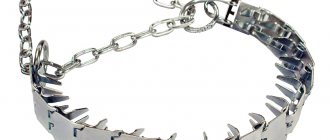Adenovirus infection
A respiratory disease in dogs (most often it is type 2 of the virus) affects the upper respiratory tract, causing inflammation and swelling of the nasal and pharyngeal mucosa.
Infectious hepatitis is caused by adenovirus type 1.
After infection, the animal develops diarrhea, vomiting, and the temperature rises to +40 °C . Puppies are more susceptible to infection; adult dogs get sick less often.
How is adenovirus infection in dogs treated?
First of all, treatment is preceded by a consultation with a veterinarian, who collects a complete medical history and a list of symptoms and the time of their manifestation. Most often, treatment can be carried out at home; hospitalization is not prescribed so often (only when pneumonia appears). For 2-3 weeks, the dog is provided with complete rest, plenty of fluids and a gentle diet, as well as a course of antibiotics, which are administered intramuscularly for at least 10 days in a row. Whether the pet is getting better should be judged by the relief of respiratory tract diseases: if normal breathing is restored, then, most likely, the animal is on the mend.
Currently reading:
- Primary and important symptoms of rabies in dogs
- Ways to manage parvovirus infection in dogs
- We fight warts on the face and body of dogs
- Thyroid dysfunction in dogs (hypothyroidism)
Consequences of infection
With type 2 infection (adenovirosis), the nasopharynx, eye mucosa, lungs, and lymph nodes are affected. After infection, the pet develops shortness of breath, coughing, accompanied by vomiting and belching. Wheezing appears in the lungs, and the lymph nodes become enlarged. Body temperature does not increase.
Type 1 adenovirus affects the dog’s liver and digestive tract. This disease is also called viral hepatitis.
Consequences of infection: vomiting, diarrhea, hemorrhages, pain in the abdominal wall. Often with infectious hepatitis, clouding of the cornea of the eye can be observed, and keratitis is diagnosed.
What kind of disease is this
The virus infects the parenchymal organs of the animal, easily penetrating the liver, kidneys, lungs and eyes. Provokes changes in the epithelial layer inside the blood vessels. It is transmitted by airborne droplets, which is why it spreads quickly in places where there are large concentrations of dogs (shelters, kennels, etc.). When introduced into the nasal passages and oral cavity, the pathogen settles on the tonsils and begins to actively multiply.
Type 1 adenovirus is considered the most dangerous. Penetrating into the blood, it enters the liver and begins to destroy the organ, penetrating into specific leukocyte cells of the liver.
It is noteworthy that the protective cells that are supposed to absorb viruses and bacteria are practically powerless against the adenovirus. The virus uses them as a means of transportation throughout the body, penetrating into its farthest corners.
Pathogen
The DNA-containing virus is resistant to low and high temperatures, thus it retains its infectious properties in both hot and cold seasons. Only alkaline disinfectants, formaldehyde or boiling for one minute can destroy virus cells.
It is important to remember these properties of the adenovirus when disinfecting premises in enclosures, shelters or at home. It is not enough to simply wash the floors and walls even with hot water; chemicals are added to the water that can deal with the virus. All accessories that can be washed are boiled; bowls and care items can be boiled in a tank.
There are two types of adenovirus:
- Type CAV1 - infectious hepatitis;
- Type CAV2 is actually an adenovirus.
Both types of infectious agents are very contagious for dogs; once they enter the body, they cause a disease of the respiratory system, which is accompanied by sneezing, runny nose, cough, swelling of the mucous membranes of the mouth and nose. The first type of adenovirus is much more severe - it affects the liver and gradually destroys it with the manifestation of symptoms characteristic of this.
Mechanism of disease development
Any pet can get a viral infection. But age and health status increase or decrease your chances of infection.
Routes of infection
The virus enters the body of a healthy dog from a sick animal.
An individual who has recovered from adenovirus becomes a carrier of the infection for several years. Infection occurs through the respiratory tract, mucous membranes, and damaged skin.
Virus resistance
The adenovirus is tenacious, its spread is not affected by weather conditions or climate, the pathogen is activated during periods of severe frost.
At an air temperature of +15...+25 °C, the virus remains active for 2 to 3 months. The source of infection is the excrement of infected animals.
The infection spreads easily; these viruses have a high level of contagiousness (damage) and are transmitted by airborne droplets.
Why is adenovirus dangerous in dogs?
The main danger of the disease is irreversible changes in the lung tissue and liver. Without timely treatment, a pet may die from internal organ failure, and a pregnant dog may experience a spontaneous abortion.
It is important to note that in dogs that have recovered from the disease, the adenovirus remains in the body for several years. For this reason, the owner must carefully observe all safety measures while walking him to avoid the spread of infection.
Manifestations of adenovirus
From the moment of infection to the appearance of the first clinical symptoms, 4 to 14 days pass. After 2 weeks, the disease progresses to the acute stage.
During this period, the dog constantly coughs, suffers from shortness of breath and vomiting.
Causes of infection
Adenovirus affects dogs with weak immune systems. Adult, healthy, strong, vaccinated individuals rarely suffer from infection.
For humans, the adenovirus that affects the immunity of dogs is not dangerous. Other pets are also not susceptible to canine infection.
How does an animal become infected?
Upon contact with a sick individual, the virus enters the respiratory system by airborne droplets, spreading throughout the body along with the blood. Especially during the infection process, the kidneys, liver, and gastrointestinal tract suffer.
Causes
Any dog can catch the adenovirus, regardless of breed and gender. If the immune system is strong, then it is able to cope with the infection on its own. If the body's defenses are weakened, the animal has every chance of becoming infected and getting sick.
Pathogens
Adenovirus infection can be caused by DNA viruses from the Adenoviridae family. In humans, pathology can occur when infected with 47 serotypes of adenoviruses.
In dogs, 2 pathogens are identified:
- CAV1 (infectious hepatitis);
- CAV2 (adenovirosis).
Adenoviruses types 1 and 2, which cause infectious hepatitis and adenovirus, are very similar in genetic structure. Can they remain active at room temperature for up to several months? remain pathogenic after several frosts. Ultraviolet radiation, as well as boiling for a minute, has a detrimental effect on pathogens.
What to do if your dog has ear pain and how to help your pet? Read useful information.
You can learn about the advantages and disadvantages of Our Brand hypoallergenic ready-made food for small breed dogs from this article.
Routes of infection
Infection always occurs through airborne droplets. Viruses can spread from a sick animal to a healthy one through direct contact:
- sniffing;
- mating;
- cooperative games.
A dog may put contaminated feces or food into its mouth. Most often, adenoviral infection can be caught:
- in the nursery;
- on a walk;
- at the veterinary clinic;
- on the dogs insert;
- at the pet store.
On a note! The causative agent of infection, penetrating the body, is first localized in the upper respiratory tract. Gradually it affects the lymph nodes, and in infectious hepatitis - the liver. The bloodstream spreads throughout the body. The lungs and gastrointestinal tract can be most affected by adenovirus.
Risk factors
In some cases, dogs can only be carriers of the virus for a long time. However, they do not show any external signs of infection. But if immunity decreases, the pathogen begins to become more active.
The development of adenoviral infection is promoted by:
- hypothermia;
- stress;
- excessive loads;
- poor nutrition;
- lack of hygiene.
Puppies under 1 year of age, as well as elderly, weakened and unvaccinated dogs are significantly susceptible to infection.
Symptoms of adenovirus infection
After contact with the pathogen, the first signs of infection do not appear immediately. It is important not to miss the initial stage of the disease in order to start treatment on time.
Onset of the disease
After infection, the virus enters the circulatory system of a healthy dog and spreads throughout the body.
At this stage, the animal exhibits the following clinical signs:
inflamed tonsils;- enlarged lymph nodes;
- slight increase in body temperature (1–2 degrees);
- shortness of breath after a walk or light physical activity.
Later, nasal discharge, coughing with vomiting or belching appears, and body weight decreases. With type 1 (viral hepatitis), vomiting and persistent diarrhea develop.
Features of the infection
The causative agent of the disease can remain in the animal’s body for up to 9 months without manifesting itself in any way. During this period, the dog is contagious to healthy individuals.
The incubation period is 14 days. At least 2 weeks pass from the moment the infection enters the animal’s body until the first clinical signs appear.
The course of the disease is from 10 to 14 days. Having been ill once, the dog acquires stable immunity for several years.
3-4 months after recovery and disappearance of the symptoms of the disease, the animal still remains infectious.
Symptoms and external signs
To successfully treat the disease, it is necessary to identify the problem in time and provide emergency assistance. Symptoms of adenovirus in dogs can manifest to varying degrees, depending on many factors. Signs may vary depending on what type of virus is present in the pet’s body.
Adenovirus type 1
The CAV1 infection quickly penetrates the body and triggers destructive processes in the internal organs. First of all, the liver is affected, and infectious hepatitis begins to develop. The following symptoms will be typical:
- Decreased appetite or complete refusal of food;
- Weakness, drowsiness, apathy;
- Rapid increase in body temperature up to 40°C;
- Nausea, vomiting, diarrhea;
- Thirst;
- Dark colored urine with an unpleasant odor;
- Painful sensitivity of the eyes to light (photophobia), the corneas become cloudy.
Dogs with strong immune systems may exhibit only some of these symptoms. This usually happens if the pet’s body has withstood the blow and hepatitis of infectious etiology has not yet begun to develop. The greatest danger of a mild form is that the animal’s vision is affected; glaucoma and corneal ulcers may develop.
Read Nausea and vomiting in dogs: causes, signs and treatment
In the case of the development of viral hepatitis of the liver, it is worth knowing about the characteristics of the manifestations of the disease in dogs at different stages:
- The hyperacute form is the most life-threatening. The virus affects the nervous system, the brain, circulates in the blood, and creates problems for the functioning of the cardiovascular system. Only 20% of puppies and 35% of adult dogs survive this stage. The owner can recognize the condition by fever, enlarged lymph nodes and liver.
- The acute form is characterized by the same processes as the hyperacute form, but the dog has more time to escape. The febrile state is not as pronounced, although the lymph nodes and liver may also be enlarged. Survival rates for treatment at this stage are 22% in puppies and 40% in adult animals.
- The subacute form is characterized by sudden exacerbations and remissions. There is a danger that the pet will not survive one of the exacerbations; immediate treatment is required. 35% of puppies and 65% of adult pets survive in this condition.
- The disease in its chronic form can be confused with dozens of other diseases with similar symptoms. There was a decrease in appetite, an increase in body temperature for a short period of time, and lethargy. There is virtually no danger to life. In this case, the animal is a carrier of the virus and can transmit it to others.
If the disease is detected at any stage, treatment is necessary, but in case of hyperacute, acute and subacute it is necessary to act very quickly. Contacting a veterinarian is mandatory.
Adenoviral infection poses a great danger to pregnant dogs, after childbirth, and after illnesses treated with antibiotics. In such cases, the animal’s immunity is already weakened. The dog can die in a matter of hours.
Adenovirus type 2
Adenovirus in dogs is a disease of the respiratory tract and organs caused by CAV2 infection. In medical terminology, synonyms can be used - viral tracheobronchitis or kennel cough. This type of adenovirus is safer for pets; death from infection rarely occurs.
Recognizing the disease is not difficult; they are difficult to confuse with signs of other diseases:
- Severe dry cough, in some cases causing vomiting or similar reactions;
- Lethargy, drowsiness, indifference;
- Enlarged lymph nodes in the neck;
- Pathological discharge of serous fluid from the eyes and nose;
- Difficulty breathing, wheezing.
It can take up to 30 days from the moment a microbial agent enters the body until symptoms of the disease appear. Most often, puppies under two months of age are susceptible to adenovirus, but there are isolated cases of adult pets being affected. Most infected dogs were not vaccinated.
Read Blood tests for dogs: types and interpretation of indicators
The high-risk group includes puppies suffering from congenital problems of the respiratory system.
Forms of viral hepatitis
Adenovirus type 1, which causes viral hepatitis, is a serious disease that is dangerous for puppies.
The infection often develops at lightning speed, and less acute forms are also found.
Regular
Symptoms: diarrhea, vomiting, malaise, apathy, fever. Clinical signs are blurred and not clearly expressed. The course of the disease is long, at least a month. Having had the usual form of viral hepatitis, most animals survive. Possible clouding of the cornea.
Acute
Immediately after the virus enters the dog’s body, the body temperature rises and lasts for 2 days.
The animal becomes lethargic, apathetic, and refuses to eat. A few days after infection, the clinical picture changes: the animal becomes thirsty, diarrhea and vomiting occur, and the pet’s weight decreases sharply. Enlarged lymph nodes, the appearance of discharge in the eye area (conjunctivitis), and clouding of the cornea are observed.
If treatment is started in a timely manner, the pet will fully recover within 10 days. If antibiotics are prescribed late, the animal dies.
Lightning fast
There is practically no chance of survival in this case.
Several hours pass from the moment of infection to death. The circulatory and nervous systems are affected. Clinical signs of the disease are absent or mild, the animal has a fever. The infection occurs in small puppies with weakened immune systems.
Treatment of adenovirus in dogs
There is no cure for adenovirus. Therefore, treatment is carried out symptomatically to reduce the severity of symptoms:
- Antibiotics are prescribed to eliminate the development of a bacterial infection that occurs as a result of a weakened immune system.
- Intravenous drips are prescribed to maintain electrolyte balance. In severe cases, blood transfusions are given.
- To eliminate adenovirosis, mucolytics are used.
Once the dog recovers, it becomes immune to adenovirus infection for life. Tissue damage may persist and will be visible on later examination, but this is not a problem or dangerous. The cornea may remain blue or cloudy after hepatitis. This makes your pet's eyes more sensitive to light, so they should be protected from the sun in the future.
Did you know? A human's brain is about 1/40 of his body weight, while a dog's brain is
—
only 1/125.
Drugs
To treat bacterial infections, broad-spectrum antibiotics are used: Ceftriaxone, Ciprovet, Betamox, Engemicin, Amoxicillin, Marfloxacin, Marfloxin, Gentamicin 8%. The drug is selected and prescribed by the doctor, taking into account the condition of the dog and the severity of the bacterial infection. Medicines are available in drops, solutions or tablets.
Antibiotics in liquid form are dissolved in drinking water and poured into the mouth using an introducer syringe. The tablets can be crushed and given along with a piece of meat or simply placed on the back of the tongue so that the pet swallows it. Don't forget to reward your dog with a treat.
To prevent electrolyte imbalance and dehydration, Bicarbonate or Ringer's lactate solution is prescribed subcutaneously in a volume of 10–50 ml, depending on the size of the dog. In serious condition, the animal is hospitalized and the medicine is infused intravenously, combined with glucose 40%.
Cough is treated with mucolytics. They thin mucus and improve breathing. Among them are the drugs “Bromhexine”, “Mukaltin”, “Terpinhydrate”. To increase immunity, immunomodulators are used - “Interferon” or “Immunoglobulin”. They are administered subcutaneously at a dose of 0.5 ml once every 3 days. You can supplement them with a multivitamin complex.
Caring for your dog during treatment at home
A sick pet is kept separately from other animals in a warm and dry room. Draft and coolness are contraindicated for him. Ensure a constant supply of clean drinking water. The diet should consist of easily digestible food: porridge with finely chopped vegetables and meat.
Did you know? Field biologists studying the wolf population in Minnesota (USA) found that 88% of adult wolves had developed immunity to the adenovirus, i.e. they successfully recovered from it.
Signs of adenovirus
Adenovirus type 2 differs from hepatitis in the manifestations and course of the disease. It affects the nasopharynx, bronchi, lungs, and eyes.
Symptoms of the disease:
- a wet cough that repeats regularly, but at first only after physical exertion;
infectious pneumonia: penetrating into the blood, the virus reaches the larynx, trachea, bronchi;- purulent discharge from the nose and eyes;
- increase in body temperature to +40 °C and above;
- passivity;
- refusal of food;
- lethargy: the dog becomes completely apathetic and does not respond to stimuli.
Subsequently, the cough becomes constant, physical activity does not affect its occurrence, and it leads to vomiting.
Diagnostics
The difficulty of diagnosing adenovirus lies in the similarity of its symptoms with other bacterial and parasitic diseases, upper respiratory tract infections, and poisoning. Therefore, only a specialist can determine the disease with a high degree of probability.
The main distinguishing feature of liver damage by adenovirus is an increase in body temperature in combination with keratitis. A blood test determines the presence of antibodies produced by the body during an adenovirus infection.
Diagnostic methods:
- analysis of swabs from the dog’s nose and throat;
- chest x-ray;
- general and biochemical blood test;
- taking stool and urine samples.
The doctor will definitely conduct an external examination of the animal and collect information about the presence of symptoms and possible causes of the disease.
Treatment
In the early stages of the disease, therapy is carried out symptomatically, the animal is wrapped up, provided with warmth and drink, and isolated from other animals. Walking and physical activity are excluded in the first days of treatment.
A sick dog is prescribed antitussive and antiviral drugs, bronchodilators, antibiotics, and glucose drips. Immunostimulants may also be needed.
Treatment can be carried out at home rather than in a clinic, since canine adenovirus is not transmitted to humans.
Diet
For the first day, the sick animal is only given clean water to drink.
Do not feed to avoid stress on the gastrointestinal tract. Every other day, the dog is given low-fat chicken broth (about half a glass). After another day, chopped lean poultry meat is added to the liquid.
3 days after the first symptoms of infection appear, fermented milk products are introduced into the diet of the domestic dog.
It is recommended to exclude fatty and sweet foods for the entire treatment period. New feeds and food products cannot be introduced.
During the recovery period, the menu should be balanced, but not heavy: cereal porridge, lean poultry, boiled vegetables, a small amount of fermented milk products. Dry food is given that is proven and familiar to the pet. It is not advisable to experiment with the selection of new brands during this period.
What will they do at the veterinary clinic?
The veterinarian will perform a thorough physical examination of the dog with standard laboratory tests. A complete blood count will be performed, including a blood chemistry panel, complete blood count, urinalysis, and electrolyte panel. Other laboratory diagnostics that need to be performed to confirm the diagnosis of infectious hepatitis in dogs include coagulation tests to test blood clotting function, anti-CAV-1 antibody serology, viral genome isolation (PCR diagnostics), and viral culture isolation. Your doctor will also check for other common dog diseases, including parvovirus and distemper.
Imaging tests will include abdominal x-rays to look for liver enlargement (hepatomegaly) and fluid accumulation in the abdomen, as well as abdominal ultrasound, which can give a more detailed look at the liver and whether it is enlarged or suffering from necrosis (cell death) . The latter method is especially necessary if there is bloating, as x-rays will show detailed images if there is fluid that makes it difficult to visualize the liver. The ultrasound image will obtain information based on the depth of the echo frequency reflected from the tissue structure. That is, cell/tissue death in the liver will show decreased echogenicity (hypoechoic), and severe fluid accumulation in the abdominal cavity will not return an echo (anechoic abdominal contents).
A liver biopsy may also be required to determine appropriate treatment for canine adenoviral hepatopathy. If the adenovirus infection is at a very early stage and is not accompanied by complications, treatment can be carried out on an outpatient basis. However, treatment is usually carried out in an inpatient setting. Fluid therapy is the mainstay of therapy for adenovirus in dogs. In this way, the electrolyte imbalance resulting from vomiting and diarrhea will be corrected. Potassium and magnesium are often very low in canine adenovirosis and must be added to infusion solutions. Component therapy with blood products will be carried out for coagulopathy (impaired blood clotting ability). If there is overt DIC in dogs with adenovirus, fresh blood products and low molecular weight heparin should be used to stabilize your dog.
Nutritional support will include frequent feeding of small portions of food as tolerated, optimized nitrogen levels and feeding the dog according to protein requirements. The amount of protein will depend entirely on your dog's individual condition, as some dogs have high amounts of protein in their bodies and others have low amounts. Improper protein restriction can impair tissue repair and regeneration. Nitrogen will be limited if your dog shows clear signs of hepatic encephalopathy (a neuropsychiatric disorder that causes inflammation of the brain and is associated with liver failure).
Partial intravenous nutrition is provided for a maximum of five days, or preferably full intravenous nutrition if the dog cannot tolerate oral feeding or tube feeding. Your doctor will prescribe antibiotics and anti-inflammatory drugs, hyperimmune serum, and blood plasma from recently vaccinated dogs if necessary.
Preventive measures
An unvaccinated animal should avoid walking areas, exhibitions, and training areas. Any gathering of dogs is dangerous for an unprotected body.
Prevention of adenovirus:
Vaccination. It is necessary to go through all stages of vaccinations, especially for young animals.- Proper care, which includes sufficient and balanced nutrition, regular visits to the veterinary clinic, and antihelminthic measures.
- Strengthening the immune system: long walks in any weather, moderate physical activity, training, active games.
A healthy adult dog rarely suffers from infectious diseases. Respiratory adenovirus has a mild course, symptoms disappear within a few days.










